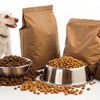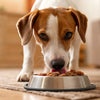How Many Calories Are in a Cup of Dog Kibble?
- Houndsy
Table of Contents
- Introduction
- The Importance of Caloric Balance in Dog Nutrition
- Factors Influencing Caloric Needs
- Calculating Daily Caloric Needs
- How Many Calories Are in Dry Dog Food?
- Practical Tips for Managing Your Dog’s Caloric Intake
- The Role of Quality in Dog Food
- Emphasizing the Feeding Experience
- Conclusion
Introduction
Did you know that nearly 59% of dogs in the United States are classified as overweight or obese? This startling statistic highlights the importance of understanding our pets' dietary needs, particularly when it comes to how many calories are in dog kibble. As responsible pet owners, we strive to ensure our furry friends maintain a healthy weight, which significantly influences their overall well-being and longevity.
In this blog post, we will delve into the world of dog nutrition, focusing specifically on the calorie content of dry dog food. We will discuss how to determine the right caloric intake for your dog, explore the factors that influence their calorie needs, and provide practical tips for managing your dog's diet. By the end of this article, you will have a comprehensive understanding of how many calories are in a cup of dog kibble and how to use this information to enhance your dog’s feeding routine.
Reflect on your own feeding practices as we guide you through this essential topic. Are you confident that your dog is receiving the right amount of calories? Let’s explore together!
The Importance of Caloric Balance in Dog Nutrition
Calories are a measure of energy, and just like humans, dogs require a certain number of calories to maintain their energy levels, support bodily functions, and stay healthy. The caloric content in dog food primarily comes from three macronutrients: proteins, fats, and carbohydrates. Each of these plays a crucial role in your dog's overall health and should be balanced according to their specific needs.
Maintaining proper caloric balance is vital for preventing obesity, which can lead to various health issues such as joint problems, diabetes, and heart disease. Conversely, underfeeding can result in malnutrition and a weakened immune system. Therefore, knowing how many calories are in dog kibble is essential for feeding your dog the right amount.
Factors Influencing Caloric Needs
Understanding your dog's caloric needs involves considering several factors:
Age and Life Stage
Puppies require more calories to support their rapid growth and development, while adult dogs need a consistent caloric intake to maintain their health. Senior dogs often need fewer calories due to decreased activity levels and metabolic changes.
Size and Breed
Larger breeds typically require more calories than smaller breeds, but this can vary significantly based on the dog's energy level, age, and metabolism. For instance, a highly active Border Collie will need more calories than a sedentary Bulldog, despite their size difference.
Activity Level
Active dogs burn more energy and therefore require more calories, while less active dogs need fewer calories to maintain a healthy weight. Factors such as daily walks, playtime, and overall lifestyle can influence how many calories your dog requires.
Health Status and Special Conditions
Dogs with certain health conditions may require a specific diet or caloric intake. For example, dogs recovering from surgery or illness may need more calories to support their recovery, while overweight dogs may require a reduction in calories.
Calculating Daily Caloric Needs
A common method to calculate a dog’s daily caloric needs is based on their weight. The general guideline is:
- For weight maintenance: Multiply your dog’s weight (in pounds) by 30, and then add 70.
- For weight loss: Multiply your dog’s weight (in pounds) by 20-25.
Example Calculation
For example, a 50-pound dog would need approximately 1,570 calories per day for maintenance (50 x 30 + 70). To adjust for activity level, you can use a multiplier based on your dog's lifestyle:
- Sedentary (little to no exercise): 1.2
- Slightly active (daily walks): 1.4
- Moderately active (regular exercise): 1.6
- Highly active (intense exercise): 1.8
Using our previous example of a 50-pound dog, if they are moderately active, the calculation would be:
1,570 calories x 1.6 = 2,512 calories per day.
For a tailored approach, it’s always best to consult with your veterinarian. They can provide insights based on your dog’s unique health needs and lifestyle.
How Many Calories Are in Dry Dog Food?
The caloric content of dry dog food can vary significantly between brands and formulations. On average, dry dog food contains between 300 and 500 calories per cup, depending on its ingredients and nutritional profile.
Here’s a breakdown of what to expect:
- Standard dog food: 300-400 calories per cup
- High-quality dog food: 400-500 calories per cup
- Weight management formulas: 250-350 calories per cup
Reading Dog Food Labels
Understanding how to read dog food labels is crucial for managing your dog's caloric intake. Look for the following information:
- Caloric content per serving: This is usually listed in kilocalories (kcal) per cup or per weight measurement.
- Guaranteed analysis: This section provides nutritional information, including protein, fat, and fiber content.
- Ingredients list: High-quality protein sources should be listed as the first ingredient, while fillers should be avoided.
Example of Caloric Content
For instance, if a dog food brand lists the caloric content as 379 kcal per cup, this means that each cup of this specific food contains 379 calories. If your dog needs 1,000 calories daily, you would need to feed approximately 2.6 cups of this food.
Practical Tips for Managing Your Dog’s Caloric Intake
Monitoring Weight and Body Condition
Regularly monitoring your dog’s weight and body condition is essential. Use a body condition score chart to evaluate whether your dog is underweight, ideal weight, or overweight. Adjust their food intake accordingly.
Portion Control
Using the Houndsy Kibble Dispenser can help ensure accurate portion control. With our dispenser, you can easily dispense the perfect amount of kibble without bending over, making feeding time more convenient and consistent. Check out our Houndsy Kibble Dispenser to simplify your dog feeding routine.
Incorporating Fresh Foods
Consider incorporating fresh fruits and vegetables into your dog’s diet as low-calorie treats. Carrots, green beans, and blueberries are excellent options that provide additional nutrients without adding excessive calories.
The Role of Quality in Dog Food
The quality of ingredients in dog food can significantly affect its caloric density and nutritional value. Opt for foods that list high-quality protein sources as the first ingredient, such as chicken, beef, or fish, and avoid fillers like corn and soy. While animal by-products are not inherently bad, understanding their source and quality is crucial. High-quality by-products can provide essential nutrients, while low-quality ones may lack nutritional value.
Grain-Free Diets
Grain-free diets have gained popularity, but they can sometimes lead to an imbalance in nutrition. Ensure that any diet you choose meets the AAFCO guidelines for your dog’s life stage and health needs.
Emphasizing the Feeding Experience
Feeding your dog should be an enjoyable experience. Use engaging feeding methods, such as puzzle feeders or interactive toys, to stimulate their minds while eating. Establishing a consistent feeding schedule can help regulate your dog’s appetite and prevent overeating. Most dogs thrive on routine, so try to feed them at the same times each day.
Conclusion
Understanding how many calories are in a cup of dog kibble is essential for maintaining your dog’s health and well-being. By evaluating your dog’s individual needs, monitoring their weight, and providing appropriate portions of high-quality food, you can help your furry friend live a longer, healthier life.
As we reflect on our own feeding practices, let’s strive for excellence in providing the best for our pets. Are you ready to elevate your dog feeding experience? Explore our Houndsy Kibble Dispenser and our accessories collection to create a convenient and stylish feeding routine that benefits both you and your beloved canine companion.
FAQ
How many calories should my dog eat daily?
The daily caloric needs of dogs vary based on factors such as age, size, activity level, and health status. Generally, adult dogs require between 20 to 30 calories per pound of body weight.
How can I tell if my dog is overweight?
You can assess your dog's weight by using a body condition score chart, which evaluates their body shape and fat deposits. Consult your veterinarian for a professional assessment and recommendations.
Are all dry dog foods the same in calories?
No, dry dog foods vary significantly in caloric content based on their ingredients and formulation. Always check the packaging for specific caloric information.
Can I feed my dog a homemade diet instead of commercial dog food?
While a homemade diet can be healthy, it’s essential to ensure it meets all of your dog’s nutritional needs. Consult with a veterinarian or a pet nutritionist to create a balanced diet.
What should I do if my dog is overweight?
If you suspect your dog is overweight, consult your veterinarian for a tailored weight management plan. This may include dietary adjustments, increased exercise, and monitoring caloric intake.












